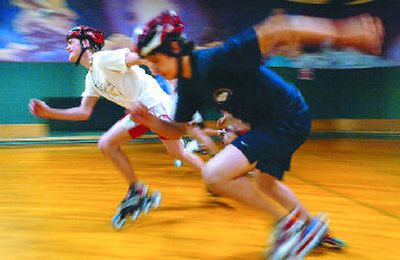In it for the speed

It’s a Monday night at Skate Plaza and under idle disco balls, ruddy-faced youths and several eager adults strap on their several hundred-dollar inline skates ahead of a whirlwind workout on the hardwood floor. In pairs, alone and grouped by age, the athletes take turns streaking past parents and other seated spectators at nearly 20 miles per hour inside the airy arena.
For the 25-odd members of the Coeur d’Alene Inline Speed Team, their extreme sport of choice is a blend of team-based racing and dazzling speed obtained through inline skating and personal exertion. And with teammates ranging in age from 4 to 45, this is a sport open to all.
“There is a lot going on in the skating world,” said Tami Martinez, whose 15-year-old son, Scott Stubblefield, has been a speed skater with the team for two years. Though Stubblefield is active in other extreme sports like mountain biking, “this is his favorite,” Martinez said. Stubblefield got some extra support for speed skating when the world’s fastest speed skater, Joey Mantia, who skates for the Federal Way team, gave the Lake City sophomore his skates.
The Inline Speed Team has been a Lake City presence for more than a decade, and some of its members enjoy the sport so much they’ve grown from former tots on the team to return years later as adults. Speed skating has undergone some major changes since a rise in popularity in the 1970s; most apparent is the move of the four wheels underneath the boot into the streamlined shape of today’s skates. That transition gave a measurable speed advantage to the inline athletes over their roller-skate counterparts.
“At its height in the ‘70s to mid-‘80s, we’d have 400 to 500 skaters at meets,” said Joe LeGault, an avid skater for more than 34 years and the inline team’s coach for two years. His daughter also skates for the team. After a drop in attendance and participation in the past decade, LeGault said: “Now we are growing again.”
For example, LeGault offered, the Coeur d’Alene team’s annual November meet drew more than 175 people last year. “We were happy with those numbers. As the word gets out, it grows and grows,” he said.
But the sport doesn’t come without some costs, chief among them the skates themselves.
“A lot of these guys are skating around on close to a thousand bucks,” LeGault said.
With today’s form-fitting boots, interchangeable wheels for indoor and outdoor races and custom frames, buying an inline athlete’s speed skates can be the most painful part of the sport. But for most of the parents with speed-skating sons and daughters, the initial costs were small when compared with their children’s overall experience.
“The cost was nonhesitant,” said Sely Heldling, who was on hand with husband Art to watch their two sons Cody, 15, and Seth, 13, practice. “I think they are hooked for life. They love it.” And, Art Heldling added: “It’s a great workout, it keeps them active.”
Cody, who is also a star athlete on the Lake City cross-country team, said it’s the speed offered by the sport that drew him in. “It’s just fun,” he said. “You kind of crave it sometimes.”
Still, when a track’s loaded with contestants bumping for position, the sport isn’t without some wicked wipeouts.
“Technically it’s a noncontact sport, but so is basketball,” LeGault said.
The inline speed skating season starts in the fall and lasts into the summer, with competitions held all over the Northwest and culminating with a May regional meet in Portland and a national meet in July. With competition coming from teams spread across Idaho and Alaska, Hawaii, Utah, Oregon, Washington and Montana, placing can be a challenge. But the North Idaho athletes, who train an average of 18 hours a week, consistently place in the top spots and have amassed more than 100 metals and trophies in the past few years.
“We’ve got some really good athletes,” LeGault said.
At a mid-February meet in Bremerton, and with not quite half their team, the Coeur d’Alene athletes placed second overall behind Federal Way, Wash., which has the largest team in the region. More recently, at an international competition in Las Vegas with hundreds of participants, the two-man relay team of Stubblefield and the elder Heldling cruised to a first-place finish.
Still, as a parent, Martinez said, qualifying takes second to what is most important about speed skating, the camaraderie and friendship that the team provides.
“This environment is one that I can drop him off and feel totally safe about it,” Martinez said about the team’s evening practices, while standing ringside as skaters whizzed by. “(Skating) has totally cleared his focus. … Honestly, it has changed my son’s life.”